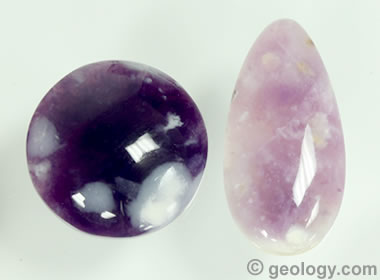Home » Gemstones » Opal » Morado Opal
Morado Opal
A purple variety of common opal from central Mexico
Author: Hobart M. King, PhD, GIA Graduate Gemologist

Morado opal: Two cabochons of morado opal. The teardrop-shaped stone on the right measures 13x26 millimeters.
What is Morado Opal?
Morado opal, also called "purple opal" and "Opal Royale," is a purple variety of common opal found in central Mexico. Its name is derived from the Spanish word "morado" which means "purple." It does not exhibit "play-of-color." Its beauty is in its wonderful purple and white colors that meet in dramatic and subtle combinations and patterns. Morado is one of the least expensive opals capable of producing designer-grade cabochons.

Morado Opal Rough: A specimen of purple "Morado Opal" in matrix mined in Mexico. The purple and white opal are swirled together in a chalcedony and quartz matrix. Measures approximately 9 x 7 x 5 centimeters.
Uses of Morado Opal
Most morado opal is cut into cabochons. Cutters willing to seek beauty over yield can produce spectacular stones from quality rough. Wonderful slabs can be purchased for a few dollars per square inch, and nice bulk rough can be purchased for under $100 per pound. Morado opal first began to appear in abundance at the 2012 Tucson Gem and Mineral Show. [1] It is a good material for people making their first attempts at cutting opal.
Morado, like all other opals, is a vulnerable gem when used in jewelry. It has a Mohs hardness of 4 1/2 to 5 1/2 and is easily scratched if used in a ring or bracelet. It is also a brittle material and is easily chipped. Morado is most appropriate for earrings, pendants and other jewelry that is not exposed to impact or abrasion.
Morado jewelry should always be stored with care. Earrings should be stored on cards, and pendants should be stored in a way that the chain will not abrade the stone. Like any opal, it should be stored where it will not be exposed to heat, cold, bright light, or temperature changes.

Fluorescence in morado opal: Shown here are two cabochons of morado opal in different lighting. The round cab fluoresces green under shortwave UV light, and the teardrop-shaped cab fluoresces blue under longwave UV light.
Physical Properties of Morado Opal |
|
| Chemical Classification | Silicon dioxide |
| Color | Purple and white |
| Streak | White |
| Luster | Vitreous, pearly |
| Diaphaneity | Translucent to opaque |
| Cleavage | None, breaks with a conchoidal fracture |
| Mohs Hardness | Variable between 4 1/2 and 5 1/2 |
| Specific Gravity | 2.1 to 2.3 |
| Diagnostic Properties | Purple and white color, hardness, low specific gravity, crazing |
| Chemical Composition | SiO2 |
| Crystal System | Amorphous |
| Uses | Gemstone |
Causes of Color and Fluorescence
The purple color of Morado opal is caused by tiny fluorite inclusions. These slightly lower the hardness of the material and cause it to require care in cutting.
The fluorite gives some specimens a blue to violet fluorescence under a shortwave ultraviolet lamp. Some specimens fluoresce a vivid green color which suggests the presence of uranium. [1]

Tiffany stone: "Tiffany Stone" is an unusual material found as mineralized nodules in a beryllium tuff at the site of the Brush-Wellman beryllium mine. It is thought to be an opalized fluorite. Tiffany Stone is also known as "bertrandite" and "ice cream opal." It is a rare material found only at the Brush-Wellman location.
Morado Opal vs. Tiffany Stone
Morado Opal and a material known as "Tiffany Stone" have a similar purple and white color and physical properties. However, they are different materials from different localities. A short description of each is provided below.
Morado opal is a purple and white common opal with minor amounts of silica from central Mexico. It is composed mainly of silica with minor amounts of fluorite. The purple color and fluorescence of the material are attributed to the fluorite. Many specimens exhibit crazing in a short time after mining.
Tiffany stone is a silicified fluorite that is found as nodules in beryllium tuff at the Brush-Wellman beryllium mine at Spore Mountain, Utah. It is purple and white in color and is often cross-cut by healed fractures containing the same material. Mineralogically it is a fluorite that is replaced by and intergrown with chalcedony, opal, quartz, and bertrandite (a beryllium silicate mineral). Tiffany stone is not subject to the degree of crazing suffered by morado opal. The name "Tiffany" has no relation to the famous jeweler and design house of the same name. [2]
| References |
|
[1] New Production of Purple Common Opal from Mexico by Nathan Renfro, a note from the 2012 Tucson Gem Show, published in the Spring 2012 issue of Gems and Gemology, a publication of the Gemological Institute of America.
[2] Tiffany Stone, article posted on the Mindat.org website. Last accessed April 2019. |
| More Gemstones |
 |
Tourmaline |
 |
Fancy Sapphires |
 |
Diamond |
 |
Canadian Diamond Mines |
 |
Birthstones |
 |
Pictures of Opal |
 |
Fire Agate |
 |
Blue Gemstones |

Find Other Topics on Geology.com:

|

| ||

|

| ||

|

| ||

|

|
